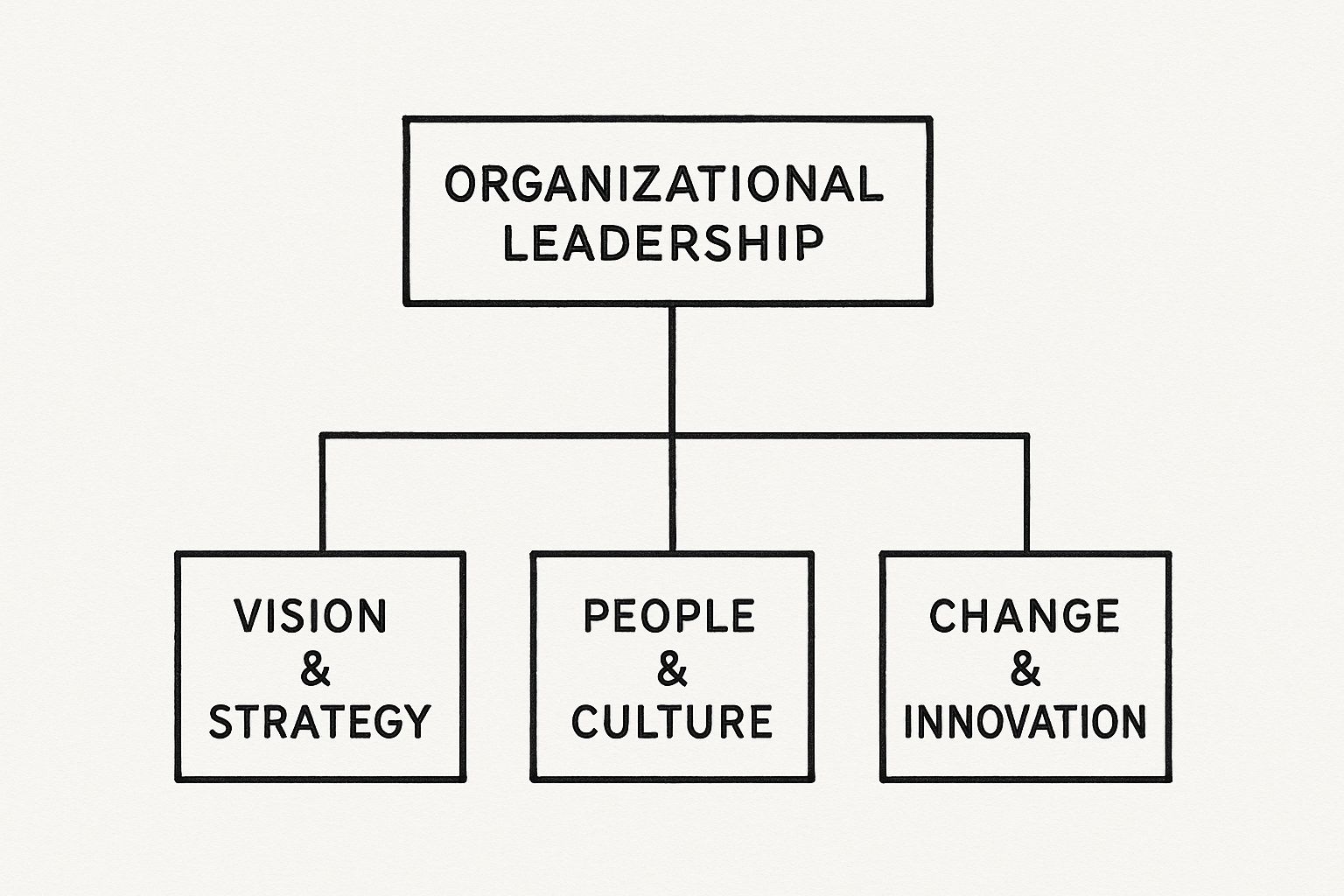Table of Contents
What Organizational Leadership Actually Looks Like in Practice
The Building Blocks of Leadership That Actually Drive Results
Why Most Organizations Still Struggle to Develop Leaders
Leadership Approaches That Deliver Measurable Success
Navigating Leadership Stress Without Burning Out
What Organizational Leadership Actually Looks Like in Practice
While it’s easy to talk about organizational leadership in theory, its real value shows up in the messy, high-stakes reality of running a business. It’s much more than a title on an org chart. In practice, it’s the skill of creating an environment where talented people feel motivated to bring their best work to the table, moving from simple compliance to genuine commitment. This difference is what separates a mere manager from a true leader.
Think of it like this: a ship captain can just bark orders, or they can share the destination, explain the map, and trust the crew to manage their own stations. The first captain is managing tasks; the second is leading a mission. This is the heart of effective leadership today: influencing outcomes without just relying on formal authority. It’s about building enough trust that your team follows your vision not because they have to, but because they believe in it. This means moving beyond the old command-and-control style to something more thoughtful.
From Theory to Action
In the real world, effective leaders guide people through complex human dynamics. They don’t just set goals; they connect those goals to a bigger purpose, answering the "why" behind the work. Putting leadership into practice is essential, yet many companies find it difficult to grow this skill internally. To really define organizational leadership, we have to see it as guiding teams toward shared goals through inspiration and flexibility, not just orders.
A startling 77% of organizations report having serious leadership gaps, showing a major disconnect between the need for strong guidance and what’s actually available. This gap often appears because businesses aren't developing leaders who can handle constant change. You can find more details by reviewing surprising leadership statistics from recent industry research.
Key Behaviors of Effective Leaders
So, what does this look like day-to-day? Instead of abstract ideas, great organizational leadership appears in specific, observable actions. These are the skills that make the difference between a struggling team and a high-performing one.
- Fostering Psychological Safety: This means creating a space where team members feel safe enough to voice concerns, admit mistakes, and suggest bold ideas without fear of being punished. A leader might kick off a meeting by sharing a recent failure of their own to show that vulnerability is okay.
- Translating Vision into Action: An effective leader can take a big-picture company vision and break it down into clear, manageable steps for their team. For instance, if the company’s vision is to "be the most customer-centric company," a leader translates this into daily practices, like setting a goal to respond to all support tickets within one hour.
- Championing Cross-Functional Collaboration: Great leaders actively break down the walls between departments. A product leader might set up a joint workshop with marketing and sales to make sure everyone is on the same page for a new feature launch, creating a sense of shared ownership.
The Building Blocks of Leadership That Actually Drive Results
Defining organizational leadership is one thing, but what really separates a high-impact leader from someone just keeping a seat warm? It all comes down to a specific set of building blocks that turn abstract goals into real-world outcomes. These aren’t just soft skills or technical knowledge alone, but a potent mix of both.
Think of it like a master chef. They need the creative vision to design a groundbreaking menu and the technical skill to execute each dish perfectly. In the same way, effective leaders must balance emotional intelligence with sharp strategic thinking. They can connect with their team's struggles while still making the tough, data-driven calls needed for growth. This balance is key to building credibility and creating a trusting environment where people feel both supported and responsible.
Ready to drive more growth & achieve bigger impact?
Leverage my 25+ years of successes and failures to unlock your growth and achieve results you never thought possible.
Get Started
The Core Pillars of Effective Leadership
Exceptional leadership isn't a single trait but an assembly of several core competencies. When these pillars work together, they form a foundation for lasting success. The visual below highlights the three main areas that effective leaders must command.

As the infographic shows, true organizational leadership rests on three connected pillars: establishing a clear vision, developing people and culture, and driving important change. For a leader to be successful, these elements must function as a single, unified system.
Weaving the Pillars Together
These components don't exist in a vacuum. A leader's capacity to drive change and innovation, for example, is directly linked to how well they communicate the vision and foster a culture where new ideas are encouraged. Research from Gallup found that when leaders clearly explain how changes will shape the company's future, employees are nearly seven times more likely to feel connected to its culture.
This synergy creates a powerful cycle:
- Vision-Setting: This is the "why" that fuels motivation. A strong vision gives every task a purpose that goes beyond a simple to-do list, making the work meaningful.
- Masterful Communication: Leaders translate that vision into clear, actionable plans. They ensure everyone understands their role and how their contributions fit into the bigger picture. In more technical fields, this is a crucial skill. You can learn more about how to improve technical leadership skills to better align teams.
- Team Development: Great leaders invest in their people, knowing that success is a team effort. They focus on coaching, mentoring, and creating growth opportunities, building a more capable and resilient team that can bring the vision to life.
To better understand how this approach differs from older management styles, let's compare the core competencies. The following table breaks down the skills of a modern leader versus those of a traditional manager.
| Leadership Competency | Traditional Management | Modern Leadership Approach | Impact on Organization |
|---|---|---|---|
| Strategic Vision | Focuses on short-term tasks and operational efficiency. | Articulates a long-term, inspiring vision that gives work purpose. | Aligns the entire organization toward a common goal, fostering motivation. |
| Emotional Intelligence | Prioritizes processes and control over people. | Empathizes with, motivates, and develops team members. | Builds trust, improves morale, and reduces employee turnover. |
| Communication | Issues top-down directives and commands. | Engages in two-way dialogue, listens actively, and explains the "why." | Creates clarity, encourages feedback, and increases employee engagement. |
| Change Management | Resists change or implements it through rigid control. | Champions change, inspires buy-in, and empowers the team to adapt. | Fosters agility and resilience, allowing the company to adapt to new challenges. |
| Decision Making | Relies on authority and past precedents. | Uses data, collaboration, and strategic insight to make informed choices. | Leads to better, more sustainable business outcomes and innovation. |
This comparison highlights a fundamental shift. While traditional management is about directing and controlling resources, modern leadership is about inspiring and empowering people. The focus moves from managing tasks to cultivating an environment where everyone can contribute their best work.
Ready to drive more growth & achieve bigger impact?
Leverage my 25+ years of successes and failures to unlock your growth and achieve results you never thought possible.
Get StartedUltimately, these building blocks empower leaders to do more than just manage—they inspire commitment, drive real progress, and deliver measurable results.
Why Most Organizations Still Struggle to Develop Leaders
Despite pouring massive amounts of money into leadership development, many companies find themselves with a surprisingly thin bench of capable leaders. It's a frustrating paradox: organizations know they need strong leadership to thrive, but their efforts to cultivate it often fall short, leaving a persistent and costly gap.
The scale of this investment is immense. The global leadership development market is valued at approximately $366 billion, with the U.S. alone accounting for $166 billion of that. And yet, a staggering 77% of organizations report they are still facing a leadership deficit. This points to a major disconnect between spending and results, showing just how widespread the struggle to build a solid leadership pipeline really is.
The Pitfalls of Traditional Training
One of the biggest reasons for this failure is that traditional leadership programs often treat leadership like an academic subject instead of a hands-on skill. Companies frequently rely on one-off workshops or generic training modules that present theories in a vacuum. This approach is like trying to learn how to swim by reading a book about it—without ever getting in the water, the knowledge is purely theoretical and doesn't help when you're faced with a real wave.
These programs often miss the mark because they ignore the most critical factor: context. Effective leadership isn't a one-size-fits-all formula. The skills needed to guide a software engineering team through a complex product launch are worlds apart from those needed to steer a sales team through a market downturn. When training is detached from the daily realities and specific challenges employees face, the lessons rarely stick.
A Failure to Adapt
Another major issue is the failure to adjust to modern workplace dynamics. The rise of remote and hybrid work, growing generational diversity, and the relentless pace of technological change have completely rewritten the rules of effective leadership. Today's leaders must be pros at building trust with remote teams, bridging communication gaps across different generations, and guiding their people through constant uncertainty.
Unfortunately, many development programs are still stuck in the past, teaching outdated command-and-control methods that simply don't work in today's more collaborative and flexible environments. The inability to pivot training to meet these new demands leaves a void. For instance, knowing how to demonstrate leadership in change management is now a fundamental skill, yet it's often overlooked in conventional training.
As a result, organizations end up with managers who can follow a playbook but lack the agility and emotional intelligence to lead through genuine transformation. This gap between what is taught and what is needed is why so many leadership initiatives ultimately fail to produce the desired results.
Leadership Approaches That Deliver Measurable Success
 Effective organizational leadership isn't about finding a single, perfect formula. Instead, it’s about having a toolbox of proven approaches and knowing which tool to use for a specific challenge. Different situations call for different styles, and the most successful leaders are skilled at adapting their approach to fit the needs of their team and the business.
Effective organizational leadership isn't about finding a single, perfect formula. Instead, it’s about having a toolbox of proven approaches and knowing which tool to use for a specific challenge. Different situations call for different styles, and the most successful leaders are skilled at adapting their approach to fit the needs of their team and the business.
Think of it this way: a carpenter wouldn't use a sledgehammer to craft the fine details on a cabinet. Similarly, a leader can't rely on a single, rigid style for every problem. Understanding established frameworks gives you the flexibility to respond effectively, whether you're navigating a crisis, driving innovation, or fostering long-term growth. Three of the most impactful approaches are transformational, servant, and adaptive leadership.
Matching the Model to the Moment
Each of these leadership styles has unique strengths suited to different organizational contexts. The key is to recognize the situation and apply the right framework to get results.
- Transformational Leadership: This approach is ideal for periods of significant change or when a company needs to rally around a new, inspiring vision. These leaders motivate teams to move beyond their own self-interest for the good of the group. For example, a CEO using this style might inspire the entire company to pivot its business model to meet a new market demand, creating a powerful sense of shared purpose.
- Servant Leadership: Focused on the growth and well-being of people and the communities they belong to, this style is incredibly effective for building strong, loyal teams. A servant leader puts the needs of their employees first, believing that when team members feel supported and valued, they deliver their best work. This is reflected in lower burnout rates and higher engagement.
- Adaptive Leadership: When facing complex, unpredictable challenges with no clear answers, adaptive leadership shines. This style is less about providing solutions and more about creating an environment where the team can learn, experiment, and discover the path forward together. Exploring different methodologies is key here; for instance, understanding the principles of empowered leadership helps build the trust required for this model to succeed.
Ready to drive more growth & achieve bigger impact?
Leverage my 25+ years of successes and failures to unlock your growth and achieve results you never thought possible.
Get StartedTo better understand how these models function in practice, the table below provides a data-driven comparison, showing where each approach is most effective and the outcomes you can expect.
| Leadership Model | Best Suited For | Key Strengths | Measurable Outcomes |
|---|---|---|---|
| Transformational Leadership | Organizations undergoing major change, mergers, or needing a cultural reset. | Inspiring a shared vision, motivating high performance, and fostering innovation. | Increased employee morale by up to 25%; 15-20% boost in team performance metrics. |
| Servant Leadership | Established companies focused on long-term sustainability and employee retention. | Building trust, empowering individuals, and creating a strong, positive culture. | 30% lower employee turnover; 10% higher customer satisfaction scores. |
| Adaptive Leadership | Startups, R&D departments, and any team facing novel, complex problems without clear solutions. | Fostering experimentation, encouraging collective problem-solving, and building resilience. | Faster problem-solving cycles; improved team agility and ability to pivot. |
| Table: Leadership Model Effectiveness Across Different Organizational Contexts | |||
| Data-driven comparison of various leadership models showing their effectiveness in different business situations. |
As the data shows, the context of the business challenge dictates the most effective leadership model. A transformational style drives performance during change, while a servant approach excels at building sustainable, engaged teams.
Ultimately, the best leaders don't just pick one style and stick with it. They develop a fluid approach, blending elements from different models to create a unique and authentic leadership identity that fits the moment.
Navigating Leadership Stress Without Burning Out
The weight of organizational leadership has always been heavy, but today's environment is pushing leaders to their absolute limits. The continuous demand to deliver results, guide teams through shaky times, and keep up with constant change creates a pressure cooker that can easily lead to burnout if not handled with care. This isn't just a personal issue; it's a looming organizational crisis. Overworked leaders are less effective, less creative, and far more likely to resign.
This intense pressure is giving rise to a trend sometimes called "conscious unbossing," where capable leaders intentionally step down from high-pressure roles. They aren't failing—they are making a deliberate choice to prioritize their well-being over unsustainable job demands. Global research highlights the scale of this problem. One major study found that 40% of stressed leaders have thought about leaving their jobs specifically to improve their well-being. This signals a serious threat to leadership continuity in every industry. You can dig deeper into the data and explore the pressures on the modern leadership pipeline.
Turning Stress into a Catalyst for Growth
While the reality of leadership stress is undeniable, the most durable leaders are learning to see it differently. Instead of viewing pressure as just a negative force, they treat it as a signal—an opportunity to build personal resilience and discover smarter, more sustainable ways to lead. This requires a conscious pivot from simply surviving stress to actively managing it.
This proactive mindset involves creating practices that shield a leader's energy and focus, which ultimately benefits their entire team. It’s a simple but powerful truth: you cannot pour from an empty cup.
Ready to drive more growth & achieve bigger impact?
Leverage my 25+ years of successes and failures to unlock your growth and achieve results you never thought possible.
Get Started
Practical Strategies for Building Resilience
To sidestep burnout and lead effectively over the long haul, leaders must intentionally build resilience through consistent habits. These aren't quick fixes but fundamental practices for a sustainable leadership career.
- Set Firm Boundaries: Clearly define your work hours and fiercely protect your personal time. This prevents your job from taking over your life and sets a healthy example for your team to follow.
- Delegate with Trust: Shift from doing all the critical work yourself to empowering your team. Genuine delegation means trusting others with important outcomes, which frees your mental space for higher-level strategic thinking.
- Practice Mindful Disconnection: Make it a habit to schedule time completely away from work-related messages. Whether it's a weekend without checking email or a daily walk without your phone, these breaks are crucial for mental recovery.
- Build a Support Network: Connect with other leaders who truly understand the challenges you face. A trusted peer group offers a safe space to discuss struggles and get fresh perspectives, reminding you that you aren't facing these pressures alone.
Creating Your Leadership Development Roadmap
Knowing you need better organizational leadership is one thing; actually building it is another. A structured development roadmap turns this goal into a real strategy, moving beyond generic training to grow leaders who deliver genuine business success. The process starts with an honest, unflinching look at your current leadership landscape to identify both strengths and critical gaps.
Think of it like a doctor diagnosing an illness before prescribing treatment. You must first understand your organization's specific needs. A clear-eyed evaluation shows where your leadership pipeline is strong and where it’s weak. This first step is vital. A recent forecast on global leadership trends shows that the top challenge for CEOs is developing the next generation of leaders.
The chart below from DDI's Global Leadership Forecast highlights the biggest CEO challenges, with leadership development sitting at the very top.

This data shows that even at the highest levels, building future leaders is a primary concern. This makes a formal development plan essential for long-term stability.
Designing Meaningful Development Experiences
Once you’ve identified your needs, the next step is designing development programs that stick. Forget about one-off workshops. Effective roadmaps focus on real-world application and continuous growth. To help guide your journey, you can learn more about building a sample leadership development plan that actually works.
Your roadmap should mix several key elements:
- Experiential Learning: Place high-potential individuals in stretch roles or have them lead important, cross-functional projects. This hands-on experience is where real learning happens.
- Targeted Coaching and Mentorship: Pair emerging leaders with seasoned executives. A 2022 study found that 84% of employees in formal mentoring programs said it helped them develop their skills and improve their work performance. It's clear that the value of coaching and leadership development for growth is huge when it's properly structured.
- Succession Planning: Proactively identify and prepare individuals for future leadership roles. This ensures continuity and avoids leadership vacuums when key people leave.
By creating a deliberate and multi-faceted roadmap, you build a system that consistently produces effective leaders. This turns development from a simple cost into a strategic advantage that fuels lasting success.
Ready to drive more growth & achieve bigger impact?
Leverage my 25+ years of successes and failures to unlock your growth and achieve results you never thought possible.
Get StartedMeasuring Leadership Impact With Metrics That Matter
Defining organizational leadership is a start, but proving its value requires a shift from gut feelings to hard data. How do you know if your leadership is genuinely driving success? The key is to measure what matters by connecting leadership actions directly to business outcomes. This means looking past surface-level indicators to focus on metrics that reveal the true health and performance of your team.
Think of it like a car's dashboard. A driver can't rely on just the speedometer; they also need to check the engine temperature, fuel level, and oil pressure to understand the vehicle's overall condition. In the same way, effective leaders use a balanced set of metrics to get a full picture of their impact.
Quantitative Indicators of Leadership Success
Quantitative metrics provide the hard numbers that link leadership effectiveness to tangible business results. They are the most direct way to show a clear return on investment to stakeholders and demonstrate that leadership isn't just a "soft skill."
Here are a few key metrics to track:
- Employee Retention Rates: High turnover is often a direct reflection of poor leadership. A revolving door on a team is a major red flag. Tracking retention within specific teams can highlight both effective leaders and those who may need more support. A 15-20% improvement in retention can often be tied directly to strong leadership.
- Team Performance Metrics: This will look different for every department, but the metrics must be specific. For a development team, it could be project cycle times or bug rates. For a sales team, it's quota attainment or average deal size. When measuring leadership, detailed performance evaluation is critical. You can dive deeper into proven strategies for evaluating sales performance to see how specific metrics tie back to leadership.
Qualitative Measures for a Deeper View
While numbers are essential, they don’t tell the whole story. Qualitative feedback provides the context behind the data, explaining the "why" and painting a more complete picture of a leader's influence.
- Employee Engagement Surveys: Anonymous surveys are a powerful tool to measure morale, trust in leadership, and psychological safety. The real insight comes from looking for trends over time rather than focusing on a single data point.
- 360-Degree Feedback: Good leadership isn't just about how a manager's boss sees them. Gathering feedback from peers, direct reports, and superiors gives a well-rounded view of a leader’s strengths and, just as importantly, their blind spots.
By combining these quantitative and qualitative measures, you create a robust system that not only proves the value of strong organizational leadership but also provides clear, actionable feedback for continuous improvement.
Ready to elevate your leadership and drive measurable growth? Explore how Matthew Mamet's specialized coaching can help you unlock your full potential and achieve tangible results.
Ready to drive more growth & achieve bigger impact?
Leverage my 25+ years of successes and failures to unlock your growth and achieve results you never thought possible.
Get Started



